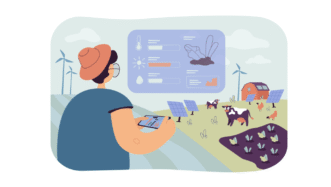LESSON OVERVIEW
In this lesson students watch two videos about AI image generators. They also learn advanced vocabulary for describing images, and do some speaking practice.
C1 / Advanced75 minStandard LessonPremium Plan
VOCABULARY FOR DESCRIBING IMAGES
In the warm-up activity, students discuss some questions about their experience with creating and modifying images. Then, they look at four pictures and match them with their descriptions. They also need to match some words from the texts (e.g. cropped, crisp, saturated, retouched) with their meanings. After that, they do a speaking activity in which they practise describing images using the new vocabulary. They also have to briefly discuss what they like or don’t like about the images and what they could be used for. At this point of the lesson, students learn that the images they were describing were created by an AI image generator.
VIDEOS & SPEAKING
While watching the first video, students need to take notes about the AI image generator called DALL-E. After the video, they share their thoughts on the ideas from the video. They also discuss what the link between the name of the AI (DALL-E) and a famous Spanish painter is. Then, they need to brainstorm some applications for AI images generators, and discuss whether they think the images are art. Next, they look at the images created by DALL-E again and try to come up with descriptions that might have been used as prompts for the AI. They can also use a free image generator to practise advanced vocabulary for describing images further. The link is provided in the teacher’s version and the e-lesson plan. Finally, students watch the video about an art contest which was won by an AI and look at some comments referring to it. The comments cover the topics of art and AI tools. Students need to say whether they agree with the comments or not and explain their views.
Subscribe to unlock these and many other Standalone lesson with the Premium planWORKSHEETS














These new lessons are really short… I’m not sure I’m happy with the change. It’s a shame.
Hi, Victoria! ESL Brains lessons are of different lengths – some 30 minutes, some 90. The lesson time we provide is estimated – a lesson might be longer with talkative students, or shorter if it’s not on the students’ level, etc.
I can attest to that. I have talkative students plus a large group. The sixty-minute lesson planners here are enough for my two-hour classes with them.
It’s really student-dependent – with the three separate students I did this with, we did it over two lessons ( so 2 hours ) – all of them had a lot to say about the subject and it helps that you are able to bring more out of them with your own questions.
Great lesson! You can easily make it longer by finding the piestro video on youtube. Then have students create pictures with Dall-E, start simple, then add a few things at a time to see how detailed you can get the photos. I’ve done this lesson with adults and fluent kids, they all have loved it. Thanks for the amazing lesson!
Thanks, Charles! Happy to hear the lesson was a success. It’s true that once you’ve played with the AI a bit, you come up with more and more crazy ideas, which can get really exciting 🙂
My students really enjoyed this lesson, we had so much fun making our own pictures at the end too!
Great to hear the lesson was fun 🙂
To add to the discussion, I agree it can vary depending on the students but it was quite quick for my upper B2/C1 group.
I think it depends as well if it’s online or face to face. F2f I think they can get more into it in pairs and then share their ideas with the group which gives more opportunity for discussion. When it’s online you need more variety of speaking material and it’s generally harder to get students to open up. Once one person has said something, generally they don’t want to repeat the same point.
Just as a suggestion/request, perhaps a different angle on speaking activities could liven things up.. so less of the what do you think about XYZ? e.g.- roleplay- imagine you are an art gallery curator and you’re not happy about this invention etc, now interact with someone who has just won a competition for digital art etc. Or- how do you think most people would answer the following question, does it differ from you own view?
Thanks, Claudia. I think you’ve made some valid points there. Your suggestions are great ideas and we will try to use them in some of the future lessons. Thanks again 🙂
One of the best lessons on here – really got into some great, indepth conversations with this one.
Thanks for sharing, Eve 🙂